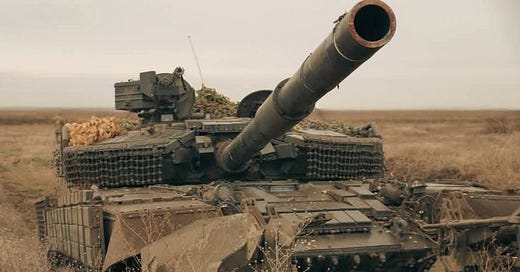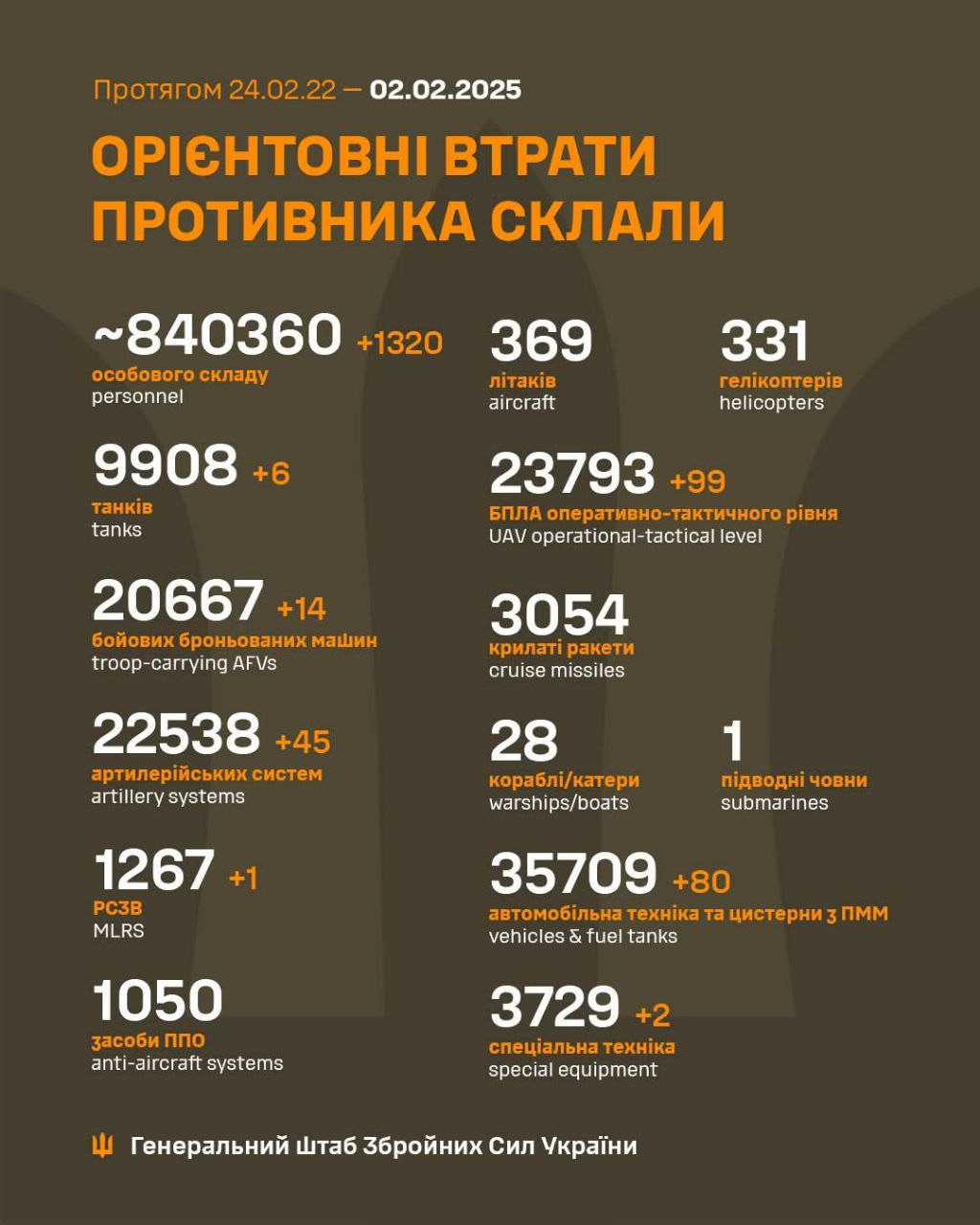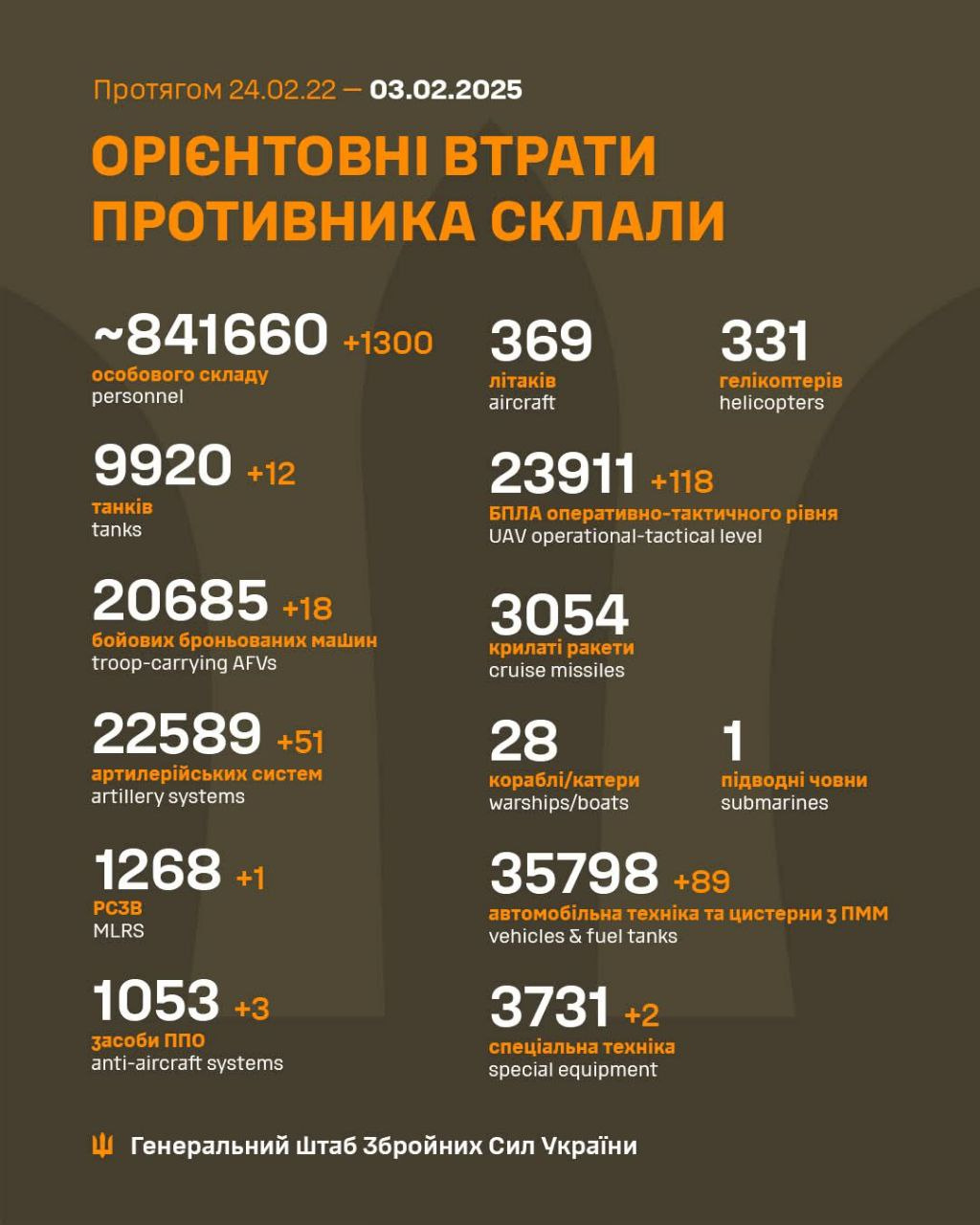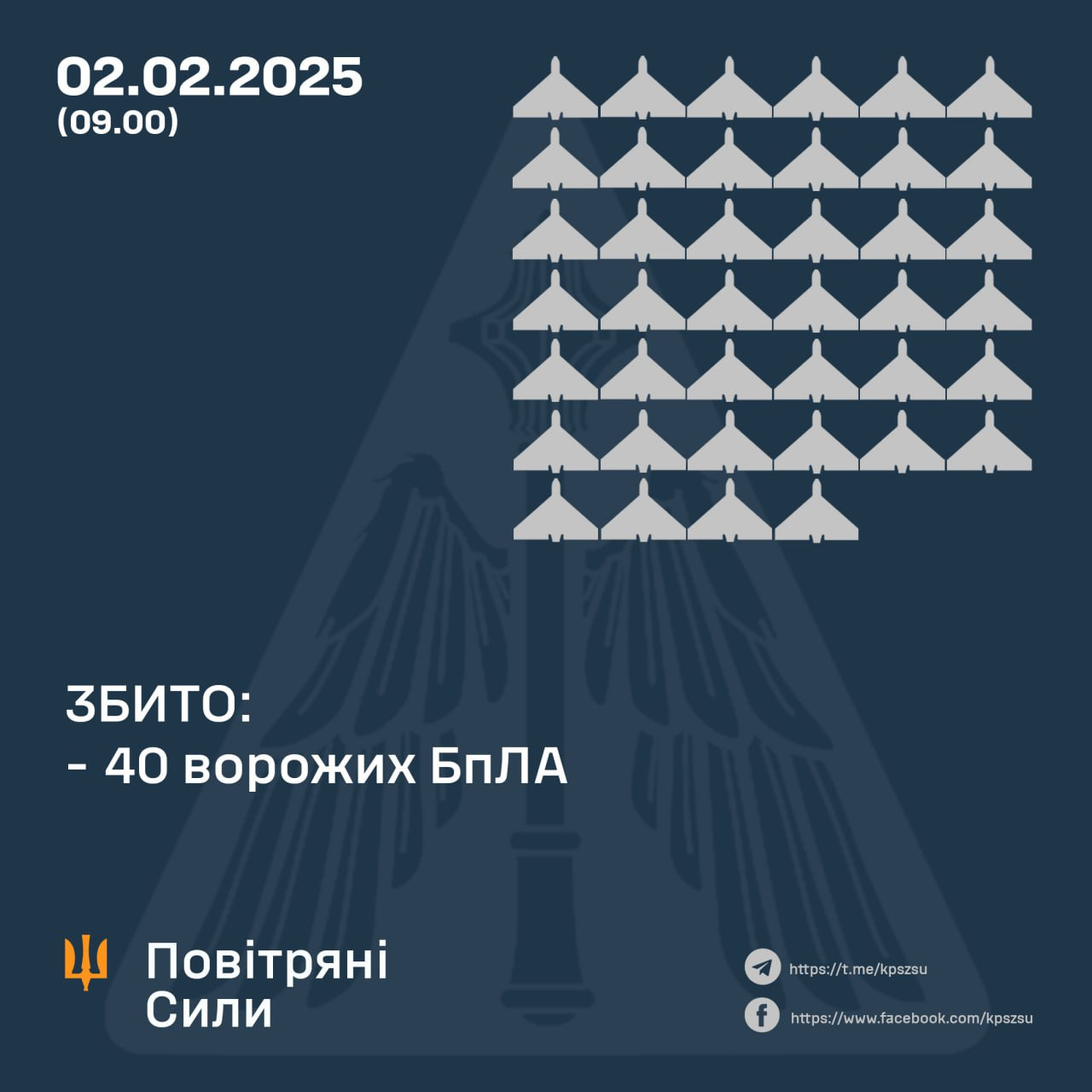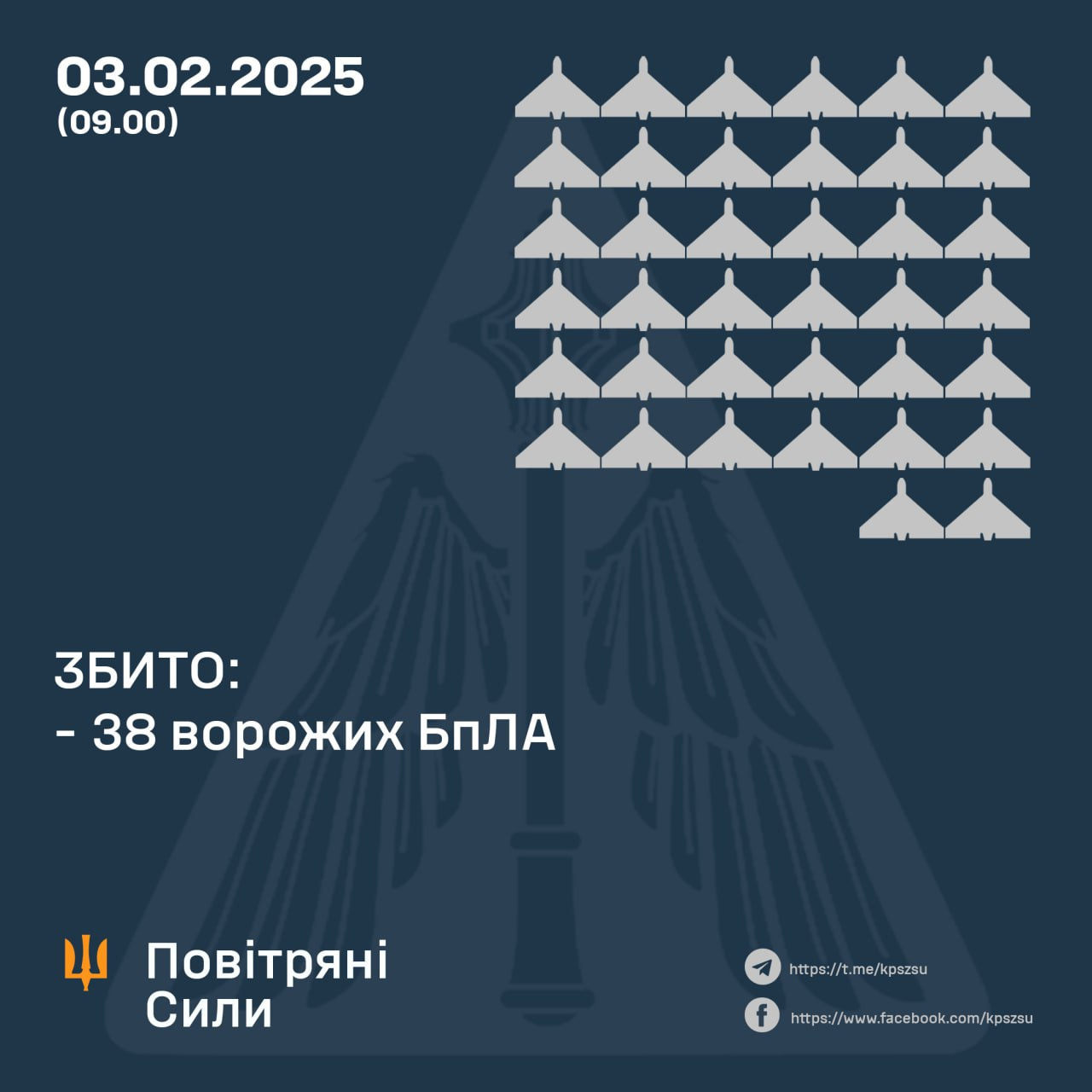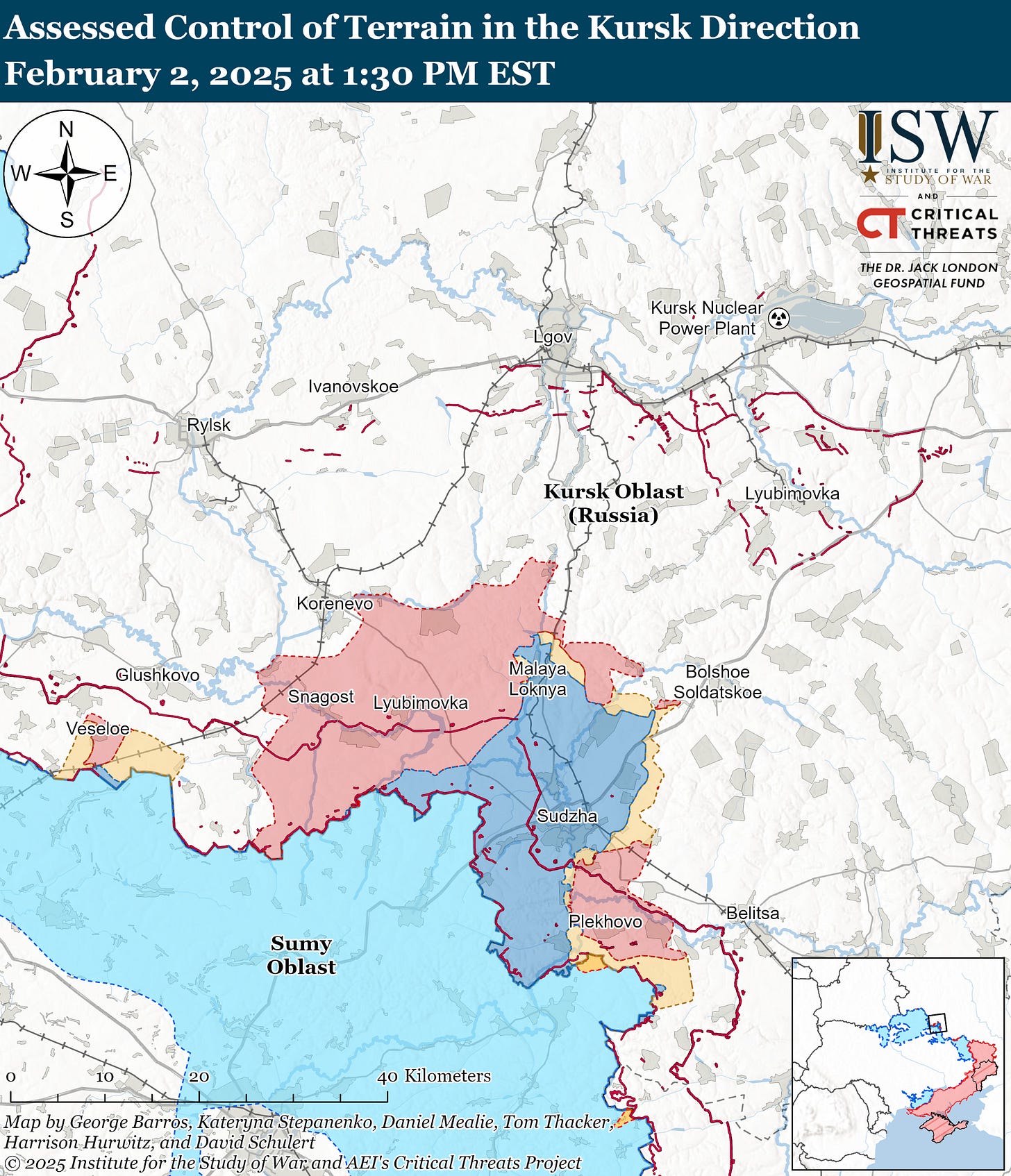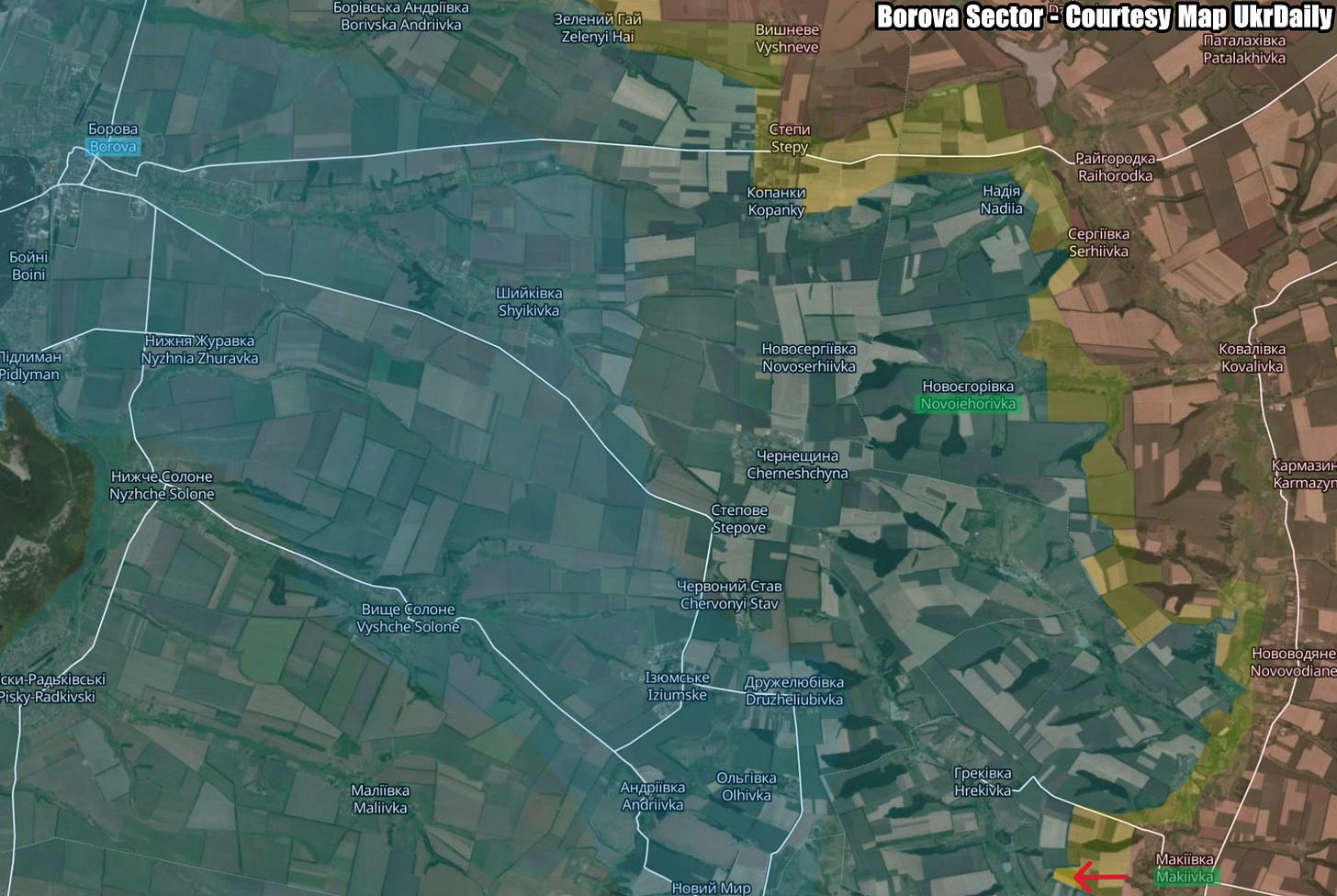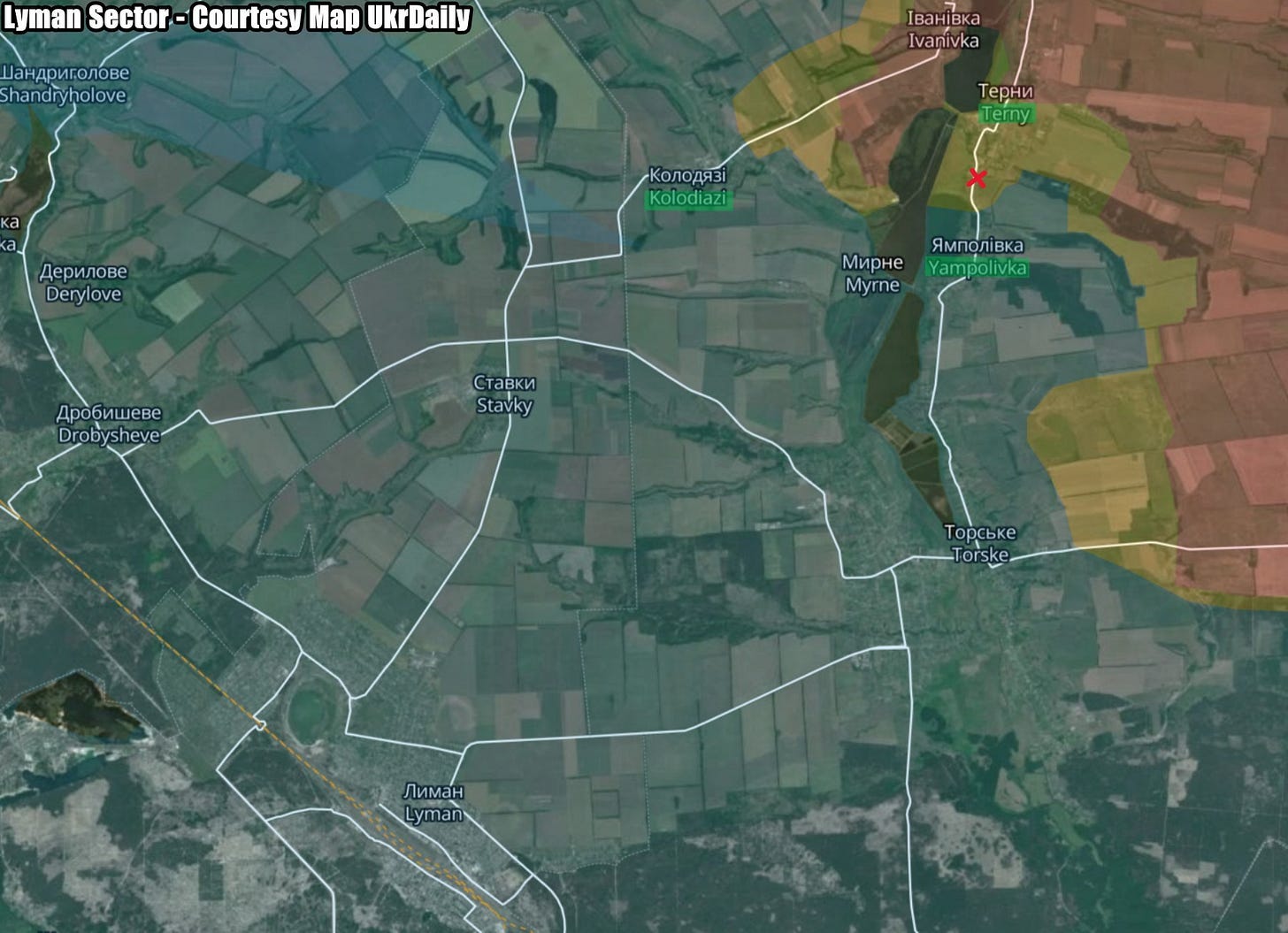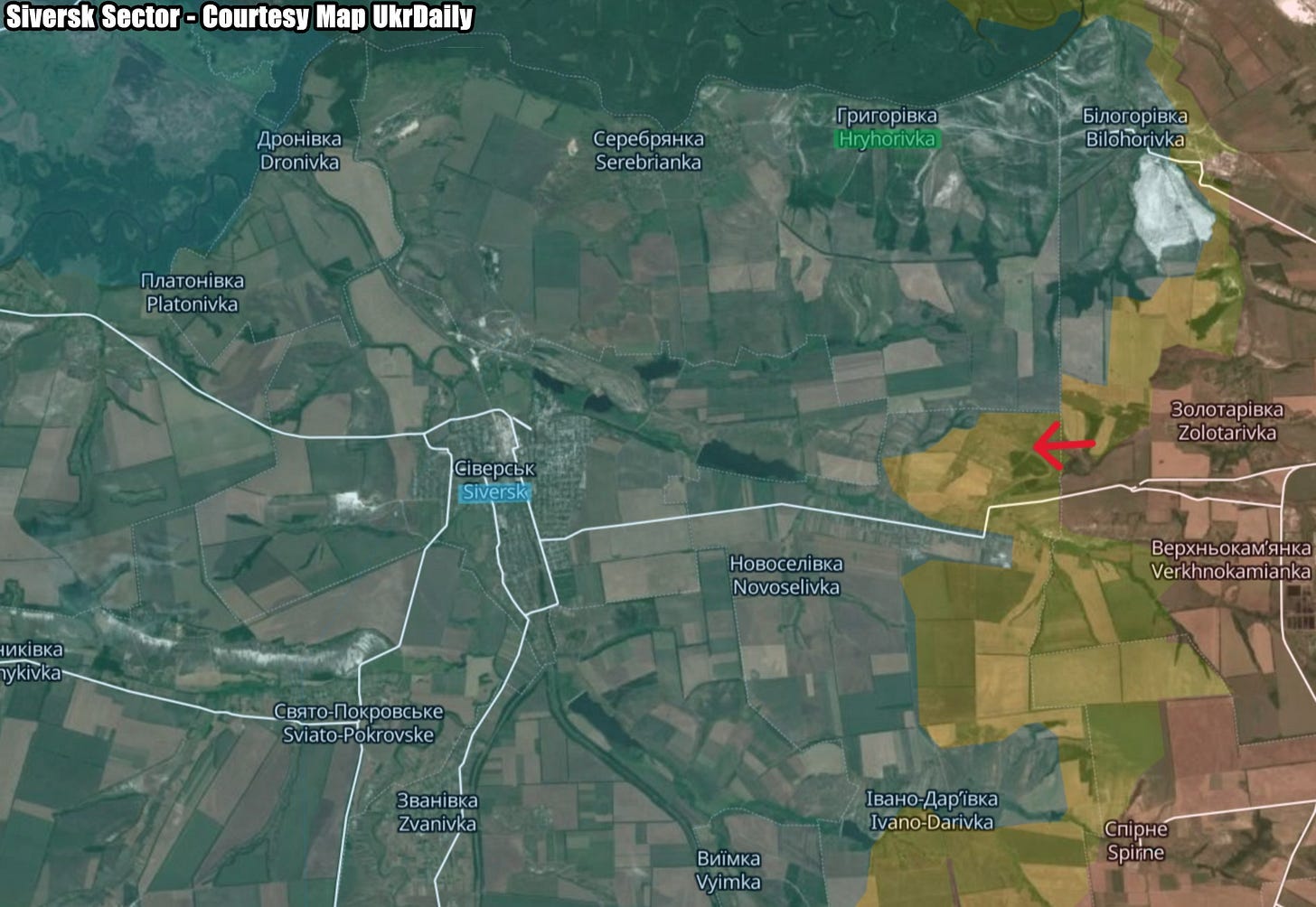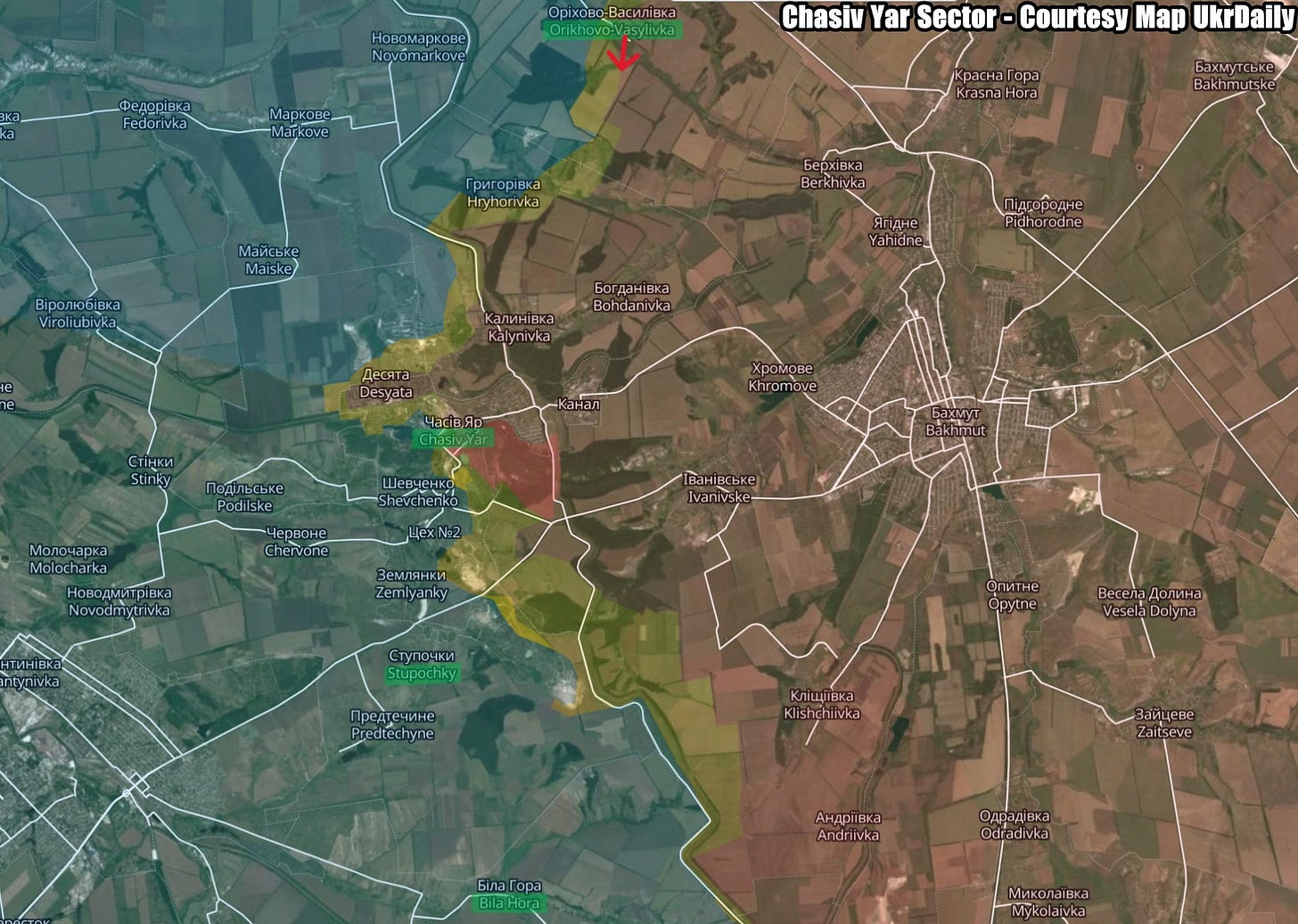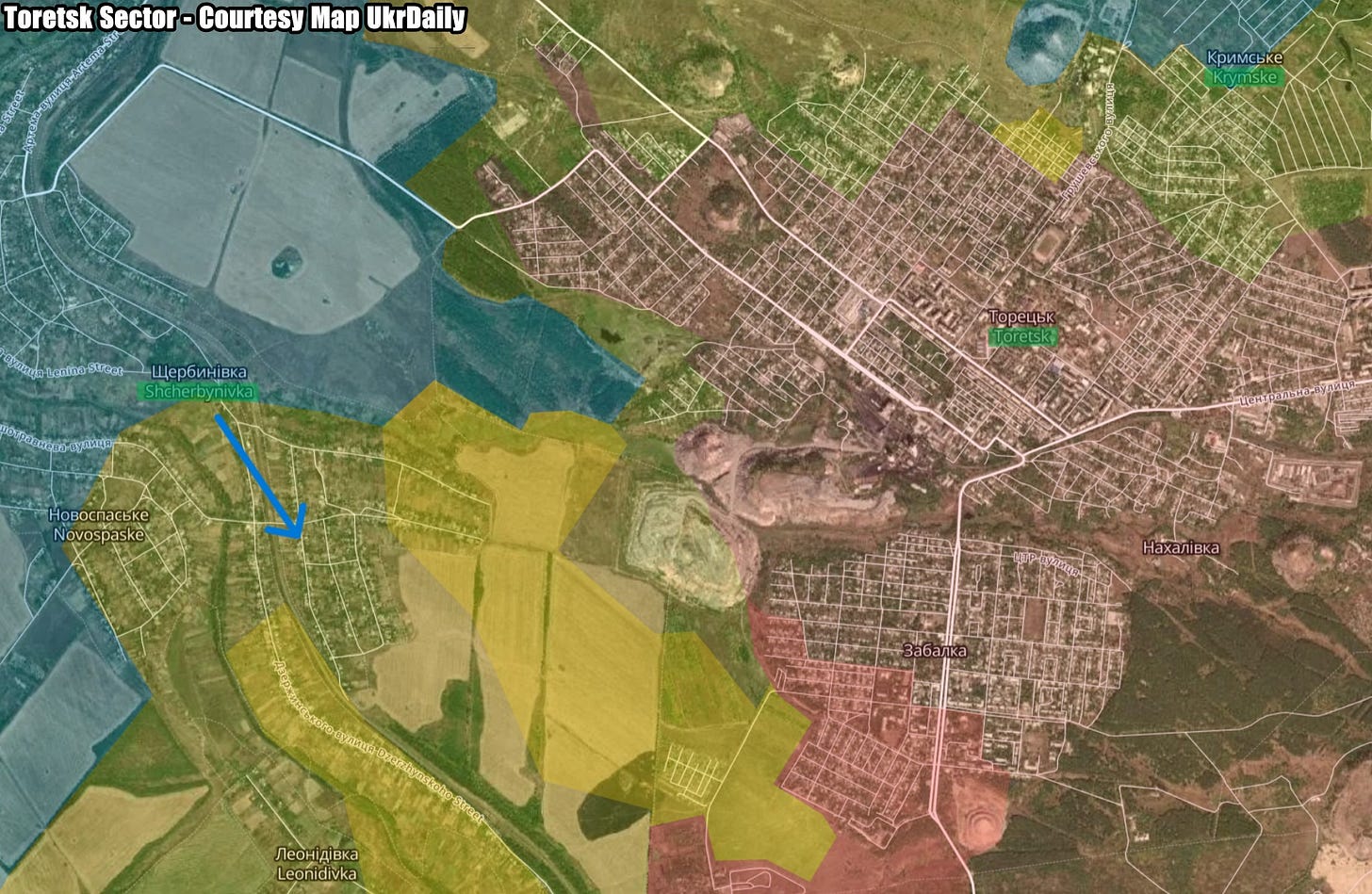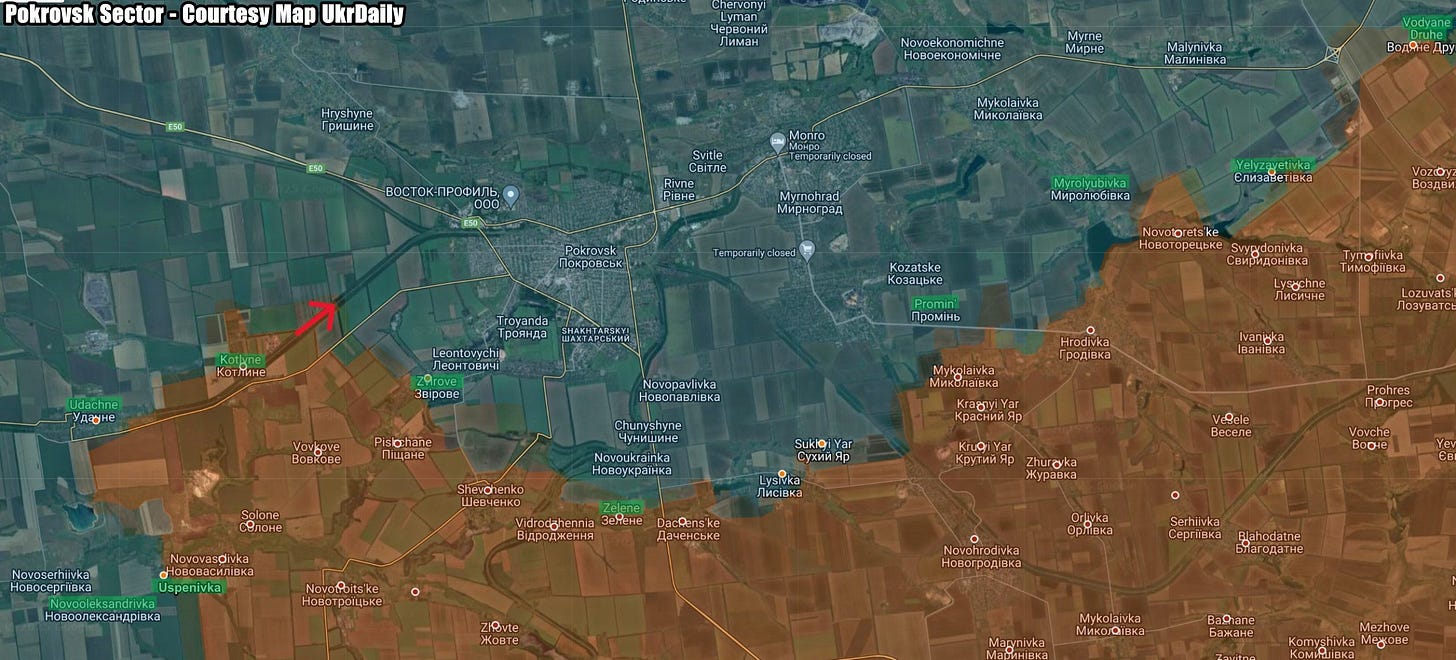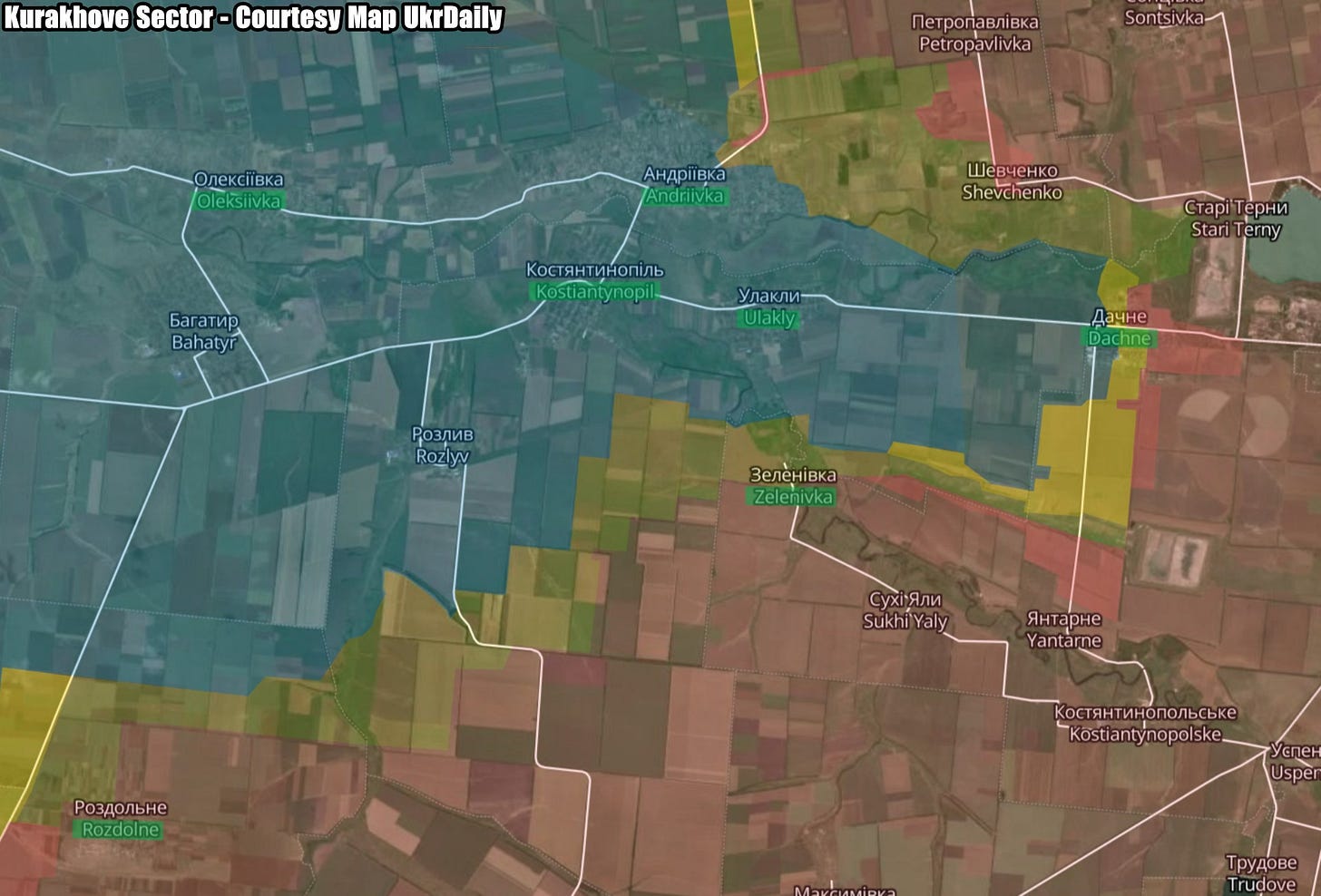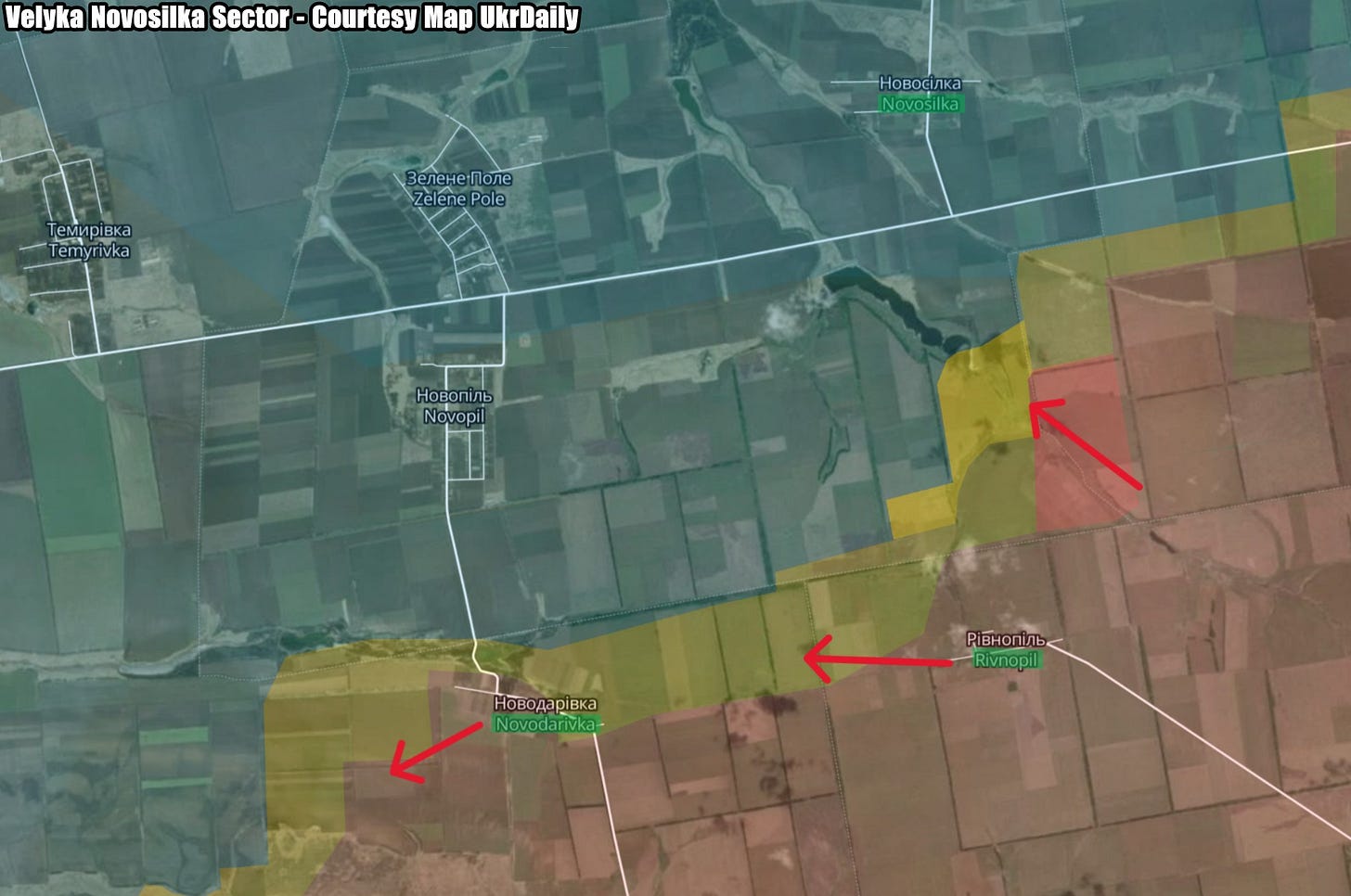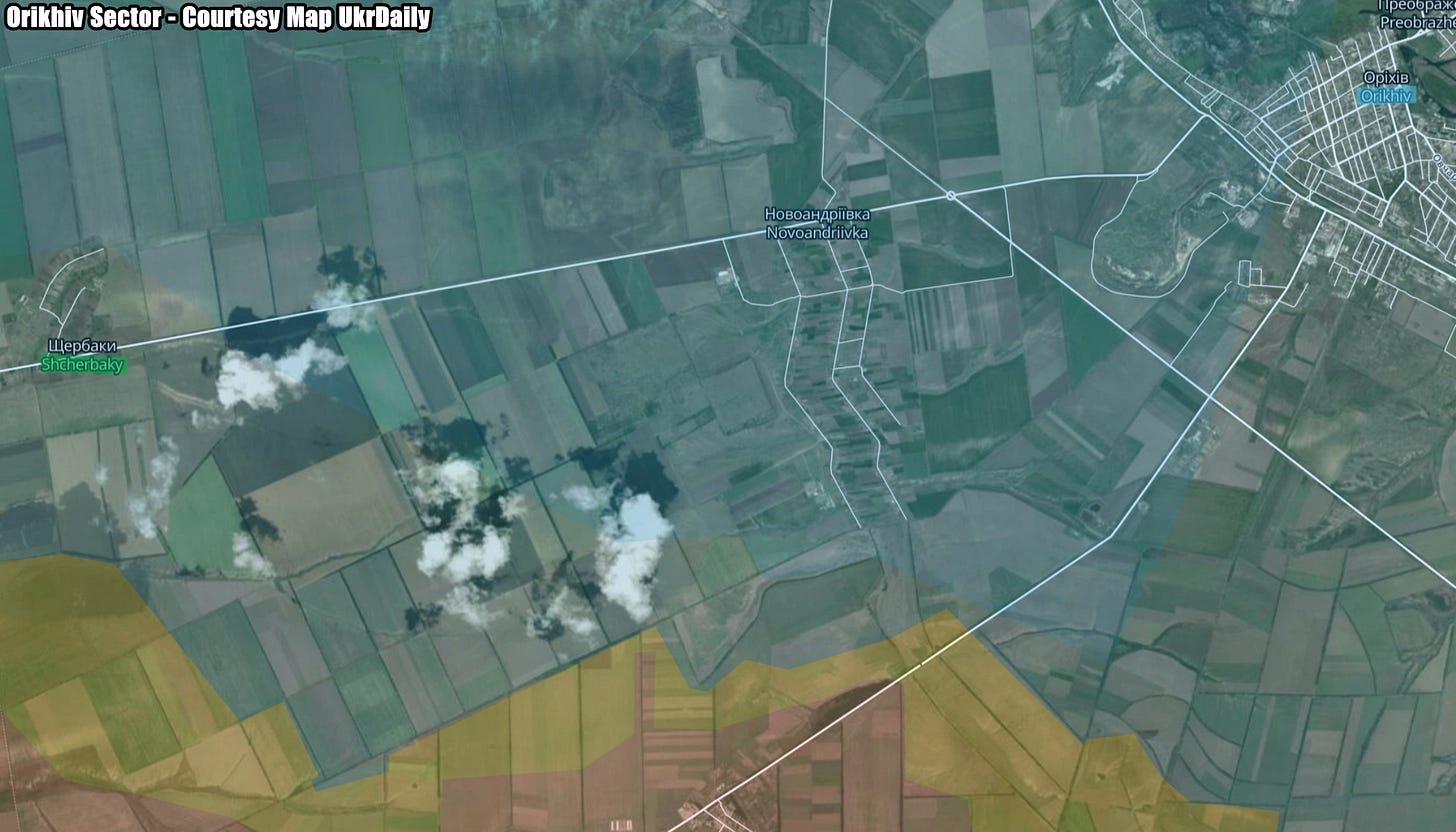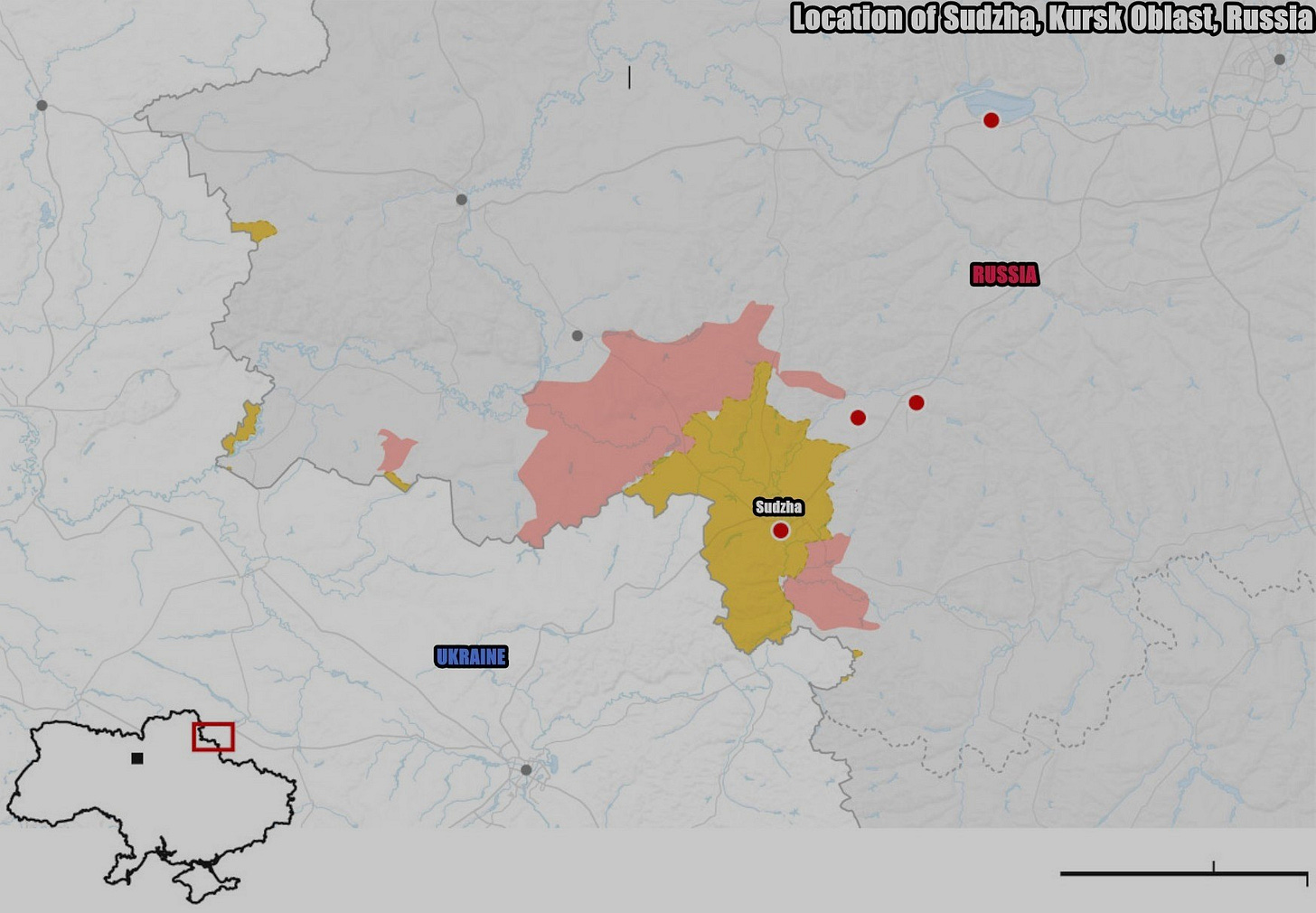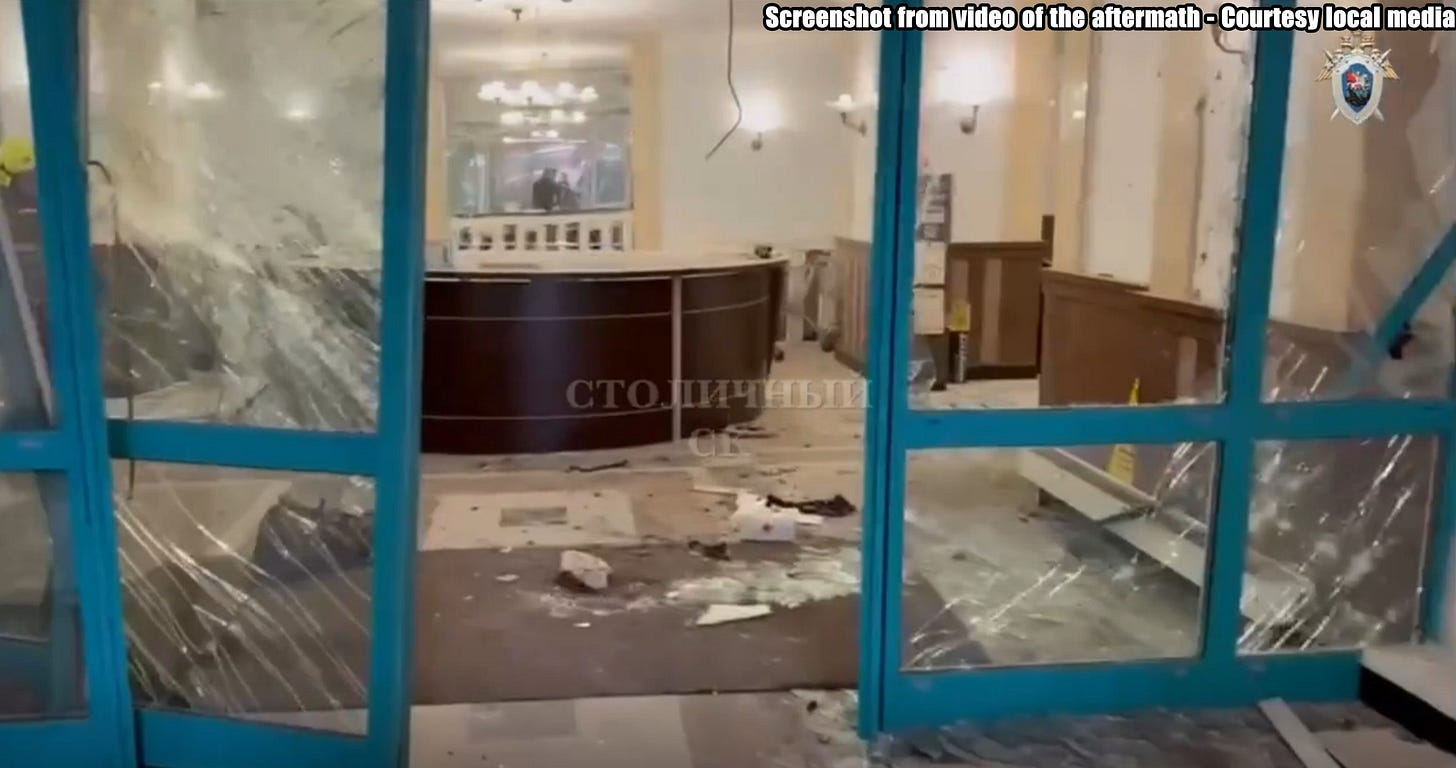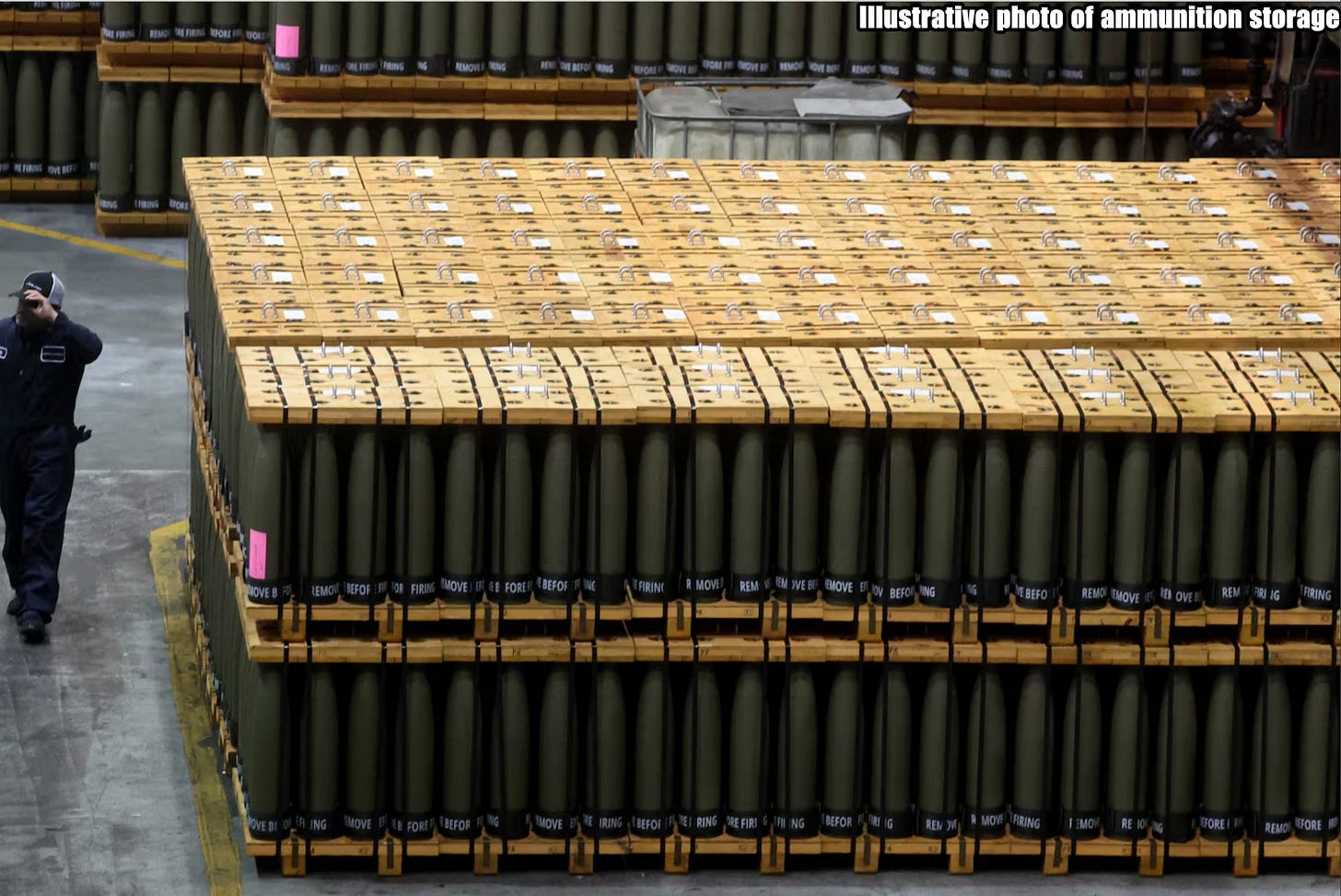Slava Ukraini! In early 2022 I began a Telegram channel aggregating news from a number of sources daily on the war in Ukraine. In June 2023 I began providing a daily draft for the Ukraine War Brief Podcast collecting news from over 70 sources daily, which formed the basis of the script. While the Podcast no longer exists I have continued to make this Brief available for my followers here on Substack for those who wish to keep up with the news from the war.
All the latest news on the Russo-Ukraine War 6 days per week
ALONG THE CONTACT LINE
GSAFU Morning Report
The General Staff of the Armed Forces of Ukraine in its Operational Information update at 08:00 on Feb 3 stated that day 1076 of the full-scale invasion of the Russian Federation against Ukraine had begun.
The situation on the line of combat remains tense in some sectors. Ukrainian defenders continue to actively counteract the Russian aggressor, causing them significant losses in personnel, equipment and technology. Exhausting the enemy along the entire front line and continuing to disrupt the plans of Russian occupiers to advance deeper into the territory of Ukraine.
During the past two days, 207 combat engagements took place.
Over the past 48 hours, the enemy carried out 5 missile strikes, 103 air strikes, used 4,725 drones and fired approximately 11,300 artillery shells across the positions of Ukrainian forces and civilians.
-
Air Force Daily Report
40 ENEMY UAVS SHOT DOWN, 13 DRONES FAILED TO REACH THEIR TARGETS (LOCATIONALLY LOST)
➖➖➖➖➖➖➖➖➖
On the night of February 2, 2025 (from 9:00 p.m. on February 1), the enemy attacked with 55 Shahed attack UAVs and simulator drones of various types from the directions: Kursk, Orel, Primorsko-Akhtarsk - Russia.
The air attack was repelled by aviation, anti-aircraft missile troops, electronic warfare units, and mobile fire groups of the Air Force and Defense Forces of Ukraine.
As of 09:00, it was confirmed that 40 Shahed attack UAVs and drones of other types were shot down in Kharkiv, Poltava, Sumy, Kyiv, Chernihiv, Cherkasy, Dnipropetrovsk, Mykolaiv, Kherson and Odessa regions.
13 enemy drone simulators were lost in location (without negative consequences).
As a result of the enemy attack, the Kharkiv and Sumy regions suffered.
38 ENEMY UAVS SHOT DOWN, 25 DRONES FAILED TO REACH THEIR TARGETS (LOCATIONALLY LOST)
➖➖➖➖➖➖➖➖➖
On the night of February 3, 2025 (from 7:00 p.m. on February 2), the enemy attacked with the 71st Shahed attack UAV and simulator drones of various types from the directions: Orel, Kursk, Bryansk, Millerovo, Primorsko-Akhtarsk - Russia, TOT Crimea.
The air attack was repelled by aviation, anti-aircraft missile troops, electronic warfare units, and mobile fire groups of the Air Force and Defense Forces of Ukraine.
As of 09:00, it has been confirmed that 38 Shahed attack UAVs and drones of other types have been shot down in Kharkiv, Poltava, Sumy, Kyiv, Chernihiv, Cherkasy, Zaporizhia, Dnipropetrovsk, Vinnytsia, and Khmelnytskyi regions.
25 enemy drone simulators were lost in location (without negative consequences).
As a result of the enemy attack, the Sumy, Kharkiv, and Cherkasy regions suffered.
Combat Operations in the Kursk Sector, Russian Federation
The Institute for the Study of War (ISW), a US based think tank, in its Feb 2 Russian Offensive Campaign Assessment reported that Russian forces continued offensive operations in the Ukrainian salient in Kursk Oblast on Feb 2 but did not make any confirmed advances. Russian milbloggers claimed that elements of the Russian 1427th Motorized Rifle Regiment (formed during 2022 partial reserve call up) attacked Kositsa from Russkoye Porechnoye (both northeast of Sudzha) and that Russian forces attacked south of Sudzha near Kurilovka, Plekhovo, and Guyevo and northwest of Sudzha near Sverdlikovo.
The Khortytsia operational-strategic group
(Responsible for the northeastern part of Ukraine. )
Borova Sector: Russian forces recently advanced in the Borova direction amid continued offensive operations in the area on Fe 2. Geolocated footage published on Feb 2 indicates that Russian forces recently advanced west of Makiivka (southeast of Borova). Russian forces attacked northeast of Borova near Zahryzove and Lozova and southeast of Borova near Novoyehorivka, Makiivka, and Novomykhailivka on Feb 1 and 2.
Lyman Sector: Russian forces conducted offensive operations northeast of Lyman near Kolodyazi, Terny, Yampolivka, and Torske on Feb 1 and 2 but did not advance.
Ukraine's Khortytsia Group of Forces reported on Feb 2 that Russian forces attacked near Yampolivka with armored vehicle support and that Ukrainian forces destroyed two armored personnel carriers.
Siversk Sector: Russian forces recently advanced in the Siversk direction amid continued offensive operations in the area on Feb 2. Geolocated footage published on Feb 2 indicates that Russian forces recently advanced southeast of Hryhorivka (northeast of Siversk).
Chasiv Yar Sector: Russian forces conducted offensive operations near Chasiv Yar itself and south of Chasiv Yar near Stupochky and Bila Hora on Feb 1 and 2. The Ukrainian General Staff published a map on February 2 indicating that Russian forces recently advanced south of Orikhovo-Vasylivka (northeast of Chasiv Yar).
Toretsk Sector: Ukrainian forces recently advanced in the Toretsk direction amid continued Russian offensive operations in the area on Feb 2. Geolocated footage published on Feb 2 indicates that Ukrainian forces recently advanced in southern Shcherbynivka (west of Toretsk). Russian forces conducted offensive operations near Toretsk itself and east of Toretsk near Krymske on Feb 1 and 2. An officer in a Ukrainian brigade operating in the Toretsk direction stated that Russian forces conducted mechanized assaults including armored vehicles, buggies, and scooters about one to two times per week. The officer stated that Russian forces often attack one settlement with three to six infantry fighting vehicles while attacking a nearby settlement with three to 10 buggies and two to three motorcycles.
The Tavria operational-strategic group
(Responsible for the central-eastern and southeastern part of Ukraine.)
Pokrovsk Sector : Russian forces recently advanced in the Pokrovsk direction amid continued offensive operations in the area on February 2. Geolocated footage published on January 27 indicates that Russian forces recently advanced along the Donetska railway line northeast of Kotlyne (west of Pokrovsk).
Russian forces conducted offensive operations east of Pokrovsk near Zelene Pole, Vodyane Druhe, Tarasivka, Myrolyubivka, and Promin and southwest of Pokrovsk near Kotlyarivka, Yelyzavetivka, Zvirove, Udachne, Uspenivka, Novooleksandrivka, and Sribne on Feb 1 and 2.
Ukrainian Commander-in-Chief General Oleksandr Syrskyi stated that Russian forces suffered more than 15,000 casualties, of which about 7,000 were killed in action, in the Pokrovsk direction in January 2025.
Kurakhove Sector: Russian forces continued attacking west of Kurakhove near Dachne, Andriivka, Ulakly, Kostyantynopil, and Oleksiivka and southwest of Kurakhove near Zelenivka and Rozdolne on Feb1 and 2, but did not advance.
A Russian source claimed that Russian forces have occupied roughly one third of Andriivka (west of Kurakhove), but ISW assesses that Russian forces occupy less than one percent of the settlement.
Velyka Novosilka Sector: Russian forces continued offensive operations near Velyka Novosilka on Feb 2. The Ukrainian General Staff published a map on Feb 2 indicating that Russian forces recently advanced west of Rivnopil, in southern Novodarivka (both southwest of Velyka Novosilka), and south of Novosilka (west of Velyka Novosilka). Russian forces continued attacking near Novopil and Novosilka (both southwest of Velyka Novosilka) on Feb 1 and 2.
Orikhiv Sector: Russian forces attacked northwest of Robotyne near Shcherbaky and Nesteryanka on Feb1 and 2, but did not advance.
The Odesa operational-strategic group
(Responsible for Kherson, Qırım, (also known as Crimea) and the Black Sea.)
There have been no major changes to the combat environment since our last report.
TEMPORARILY OCCUPIED TERRITORIES
Nothing major to report.
THE HOME FRONT
Ukraine foils Russian-backed plot to blow up Rivne Oblast railway.
The Security Service of Ukraine (SBU) said on Feb. 3 that it had prevented a sabotage attempt on a railway in Rivne Oblast, arresting a 23-year-old man allegedly working for Russian intelligence services. The Kyiv Independent reports.
"The man, on the instructions of the Russian intelligence services, came to the city of Sarny to blow up the railway tracks of the junction station through which trains with military equipment for the Armed Forces pass," the SBU said in a statement.
The suspect was detained near the tracks while attempting to place explosives intended for remote detonation. Investigators learned that he was also tasked with gathering intelligence on military facilities in Lviv Oblast, according to the SBU.
The SBU noted that the man had previously expressed pro-Russian views on social media and wanted to move to Russia. He had previously been prosecuted for desecrating Ukrainian soldiers' graves and was reportedly recruited by Russia due to his ideology.
The man has been charged with high treason and sabotage under martial law, offenses punishable by life imprisonment and confiscation of property.
The arrest comes days after the SBU dismantled a Russian spy network on Jan. 28 that was gathering intelligence on Ukrainian aircraft and aviation infrastructure for potential strikes.
RUSSIAN WORLD
Russia bombs a dormitory containing Russian evacuees in Sudzha
The Institute for the Study of War (ISW), a US based think tank, in its Feb 2 Russian Offensive Campaign Assessment reported that Russian forces reportedly struck a dormitory holding Russian civilians in Sudzha, Kursk Oblast on Feb 1 as Russian authorities widely attempted to deny Russian responsibility for the strike and blame Ukraine. Ukrainian President Volodymyr Zelenskyy and the Ukrainian Air Force reported that Russian forces conducted a guided glide bomb strike against a former boarding school dormitory holding 84 local Russian civilians preparing to evacuate and four Ukrainian police officers. The Ukrainian General Staff reported that the strike wounded four people and killed four. The Ukrainian Air Force warned that Russian sources are attempting to blame Ukraine for the strike.
The Russian Ministry of Defense (MoD) and senior Russian officials claimed that Ukrainian forces conducted a missile strike from Sumy Oblast against a dormitory holding civilians in Sudzha. Russian milbloggers widely claimed that Ukrainian forces conducted the strike. Russian opposition outlet Agentstvo reported that Russian state-run TV stations Channel One (Perviy Kanal) and NTV claimed that Ukrainian forces conducted the strike against a dormitory holding civilians in Sudzha but also reported Russian airstrikes on Ukrainian positions in Kursk Oblast.
Grumpy here - We can tell the Russians are lying because their lips are moving.
Pro-Russian paramilitary leader dies in hospital after Moscow explosion.
Armen Sarkisyan, a pro-Russian collaborator from Donetsk Oblast wanted by Ukraine, died in the hospital after being injured in an explosion in an elite residential complex in Moscow on Feb. 3, the Kyiv Independent reported citing Russian state propaganda agency TASS, who in turn cited healthcare officials.
The leader of the Kremlin-aligned Arbat paramilitary unit was severely injured when an unidentified explosive device went off in the lobby of one of the buildings in the"Alye Parusa" (Scarlet Sails) residential complex in northwestern Moscow.
The collaborator was initially reported killed, but the Russian media later clarified he was transported to the hospital and had to undergo a leg amputation.
Russia's Investigative Committee, which launched an investigation into the explosion, later confirmed Sarkisyan had died in the hospital.
Sarkisyan was a Donetsk Oblast crime boss and a close former associate of Ukraine's pro-Kremlin ex-President Viktor Yanukovych. He had been on an international wanted list since 2014 for organizing murders in central Kyiv, the Security Service of Ukraine (SBU) said.
During the EuroMaidan Revolution, Sarkisyan reportedly organized the hired pro-government thugs ("titushky") who harrassed pro-EuroMaidan protesters.
After the full-scale invasion broke out, Sarkisyan founded the Arbat Separate Guards Special Purpose Battalion, a paramilitary unit linked to the Russian Defense Ministry and fighting against Ukraine. The group is reportedly mostly made up of ethnic Armenians, many of whom have criminal records.
The explosion reportedly occurred when Sarkisyan and his security guards were entering the building. Five people were reported injured in the blast overall, while one of the guards was said to have been killed.
Serhii Shkriabatovskyi, a native of Ukraine residing in Russia, was among those injured, the independent outlet Agentstvo wrote, identifying him as a member of Yanukovych's security detail in 2013-14.
Russian law enforcement services suspect that Sarkisyan was a victim of a planned assassination, TASS reported. The Kyiv Independent could not verify the claims. It is currently unclear who was behind the explosion.
Ukrainian drones strike 2 major energy facilities in Russia.
Ukrainian drones attacked an oil refinery in Volgograd and a gas processing plant in Astrakhan in Russia overnight on Feb. 3, a source in the Security Service of Ukraine (SBU) told the Kyiv Independent.
The drones, operated by the SBU and the Special Operations Forces, targeted the flare farm, two primary processing units, and two technological units at the Volgograd oil refinery, owned by Lukoil, one of Russia's largest oil producers, the source said.
The gas condensate processing complex at the Astrakhan Gas Processing Plant was also reportedly damaged. The facility has halted operations as the fire continues.
Both targeted facilities are said to be major fuel producers for the Russian military.
INTERNATIONAL NEWS
Biden administration slowed Ukraine arms shipments until his term was nearly done.
In the final year of President Joe Biden’s term, decisions on key shipments and weapons in Ukraine were stalled not just by months of congressional delays, but also by internal debates over escalation risks with Russia, as well as concerns over whether the U.S. stockpile was sufficient, a Reuters investigation found. Adding to the confusion was a chaotic weapons-tracking system in which even the definition of “delivered” differed among U.S. military branches.
Including the splashy April 2024 aid package, the Biden administration authorized a monthly average of about $558 million through September. The average value of shipments accelerated sharply after Trump won the presidential race, to levels not seen since mid-2023, the Reuters analysis found.
But despite the Biden team’s billing of the later announcements as a surge in aid from October through Inauguration Day, monthly aid from the U.S only reached the $1.1 billion monthly average established during the first two years of the war, the analysis found.
By November, just about half of the total dollar amount the U.S. had promised in 2024 from American stockpiles had been delivered, and only about 30% of promised armored vehicles had arrived by early December, according to two congressional aides, a U.S. official, and a lawmaker briefed on the data.
In April 2024, the long-awaited passage of the aid package unlocked $60 billion for Ukraine.
“I’m making sure the shipments start right away,” Biden said on April 24.
The Pentagon announced a $1 billion weapons package, but package sizes quickly dwindled. And actual deliveries were slow and sporadic.
The chaotic tracking skewed Pentagon data and made it almost impossible to accurately pinpoint the weapons in the shipping process at any given time, according to public reports from the Government Accountability Office.
By mid-May, Biden agreed to relax restrictions – in limited circumstances and range. U.S. rockets were allowed to fire across the Russian frontier to protect against cross-border attacks on the Kharkiv region, said two U.S. officials familiar with the Pentagon’s communications with Ukraine.
Sullivan also said at a May 13 press briefing that the U.S. was trying to “accelerate the tempo” of weapons shipments.
But by July, shipments were still delayed, Ukrainian officials said. Zelenskiy’s top advisor Yermak said publicly that some weapons the U.S. had announced in April had yet to arrive.
Zelenskiy expressed similar sentiments during the NATO summit in Washington.
Shipping U.S. weapons abroad in wartime requires complicated logistics and coordination among multiple American agencies and allied governments. It can take months.
For Ukraine, the Pentagon shipped inventory from its warehouses around the world by a combination of truck, air, ship and rail.
Smaller arms packages could arrive in a week or two, according to four U.S. officials with knowledge of the process. For larger deliveries, and when Washington tried to ship weapons in bulk, the process was slower. If something needed repairs, it could take up to four months.
Most U.S. shipments over the summer were limited: They included short-range air defense interceptors, replacement vehicles, and artillery so Ukraine could defend itself, but not launch significant offensives, the Reuters analysis found.
More aggressive weaponry – sophisticated air-to-ground missiles for F-16s, and expensive missiles that hunt radar arrays – was held back, according to the analysis of spending data and Pentagon announcements.
Multiple U.S. officials with knowledge of the matter attributed the decisions to hold back aggressive weaponry through last summer to fears that American stockpiles were running low.
Through summer, the U.S. announced delivery numbers on the Pentagon’s website that appeared to indicate that almost everything promised from U.S. stockpiles had been delivered.
But separate investigations by the Pentagon’s inspector general and the Government Accountability Office found that the administration seemed unaware how many weapons had been delivered – or how much the shipments lagged.
On Sept. 26, recognizing that the summer shipments were too slow, Jake Sullivan sent a series of Cabinet memos pushing the Pentagon to speed up deliveries. He set deadlines and demanded regular updates on key weapons, two senior U.S. officials said.
The Pentagon would have to move a monthly average of $1.2 billion – the same rate as in 2022 and 2023, but twice what it had moved in the six months prior.
Zelenskyy kept pushing, saying in an interview Oct. 30 that only 10% of U.S. military aid approved by Congress in 2024 had arrived. The statement angered Washington officials, who told reporters that Ukraine was downplaying deliveries to get more support from European countries.
The Pentagon did not provide Reuters with an overall estimate of how much of the promised weapons from U.S. stockpiles were delivered to Ukraine in Biden’s last year. But a spokesperson for the agency said that as of Jan. 10, the U.S. had delivered 89% of critical munitions and 94% of anti-armor systems. The plan, still in place when Trump took office Jan. 20, is to deliver more armored vehicles next summer, another U.S. official said.
MILITARY & TECH
KNDS Will Buy a German Railcar Plant to Produce Parts For RCH 155 and Leopard 2
Arms manufacturer KNDS Deutschland, part of the defense conglomerate KNDS, is planning to acquire a railway car–building plant in the German city of Görlitz and convert it to produce components for Leopard 2 tanks and RCH 155 self-propelled artillery systems. As Spiegel reports, the decision has already been made, and the contract will be signed this Wednesday in the presence of Chancellor Olaf Scholz.
The nuance of the situation is not only that this commitment represents a large-scale "beating of plowshares into swords" in turbulent times but also involves a legendary enterprise with over 150 years of operating history.
The said wagon-building plant currently belongs to the French manufacturer of railway equipment Alstom, and it will start its transition at a moderate pace: defense production at the factory in Görlitz should launch only in 2026 and reach full capacity only by early 2030s. The anticipated product range will include only welded assemblies made of armored steel for RCH 155 and Leopard 2 at these initial stages.
Apparently, KNDS Deutschland is taking over this plant to unclog bottlenecks in its production chains. It will help fulfill the commitments before the Bundeswehr, currently counting 132 Leopard 2 tanks and 150 Boxer wheeled armored vehicles already commissioned, plus another 80 RCH 155 units expected to be ordered soon.
The first time the plans to sell the Goerlitz wagon factory were discussed in public in August 2024, implying that a buyer interested in some relatively free production capacity was found quite quickly. KNDS Deutschland is ready to pay a double-digit amount in millions of euros, and the German government will preserve 700 jobs that feed 5,000 people in this German city.
During World War II, this factory served as a dual-purpose facility for the production of military equipment. In a sense, it has returned to its origins.
That’s it for today’s Brief folks if you would like to keep up with events in Ukraine daily please consider subscribing, it’s free!


